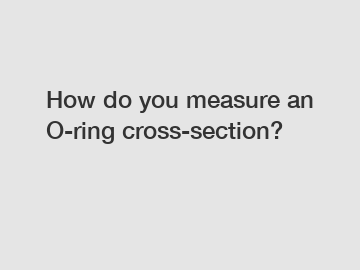How do you measure an O-ring cross-section?
How do you measure an O-ring cross-section?
O-rings are essential components in many industries, ensuring a tight and reliable seal between two parts. However, to ensure the correct fit and performance, it's crucial to measure their cross-section accurately. Proper measurement helps in selecting the appropriate O-ring size for specific applications, preventing leaks, and ensuring optimal performance. In this article, we will delve into the various methods used to measure an O-ring cross-section, highlighting their advantages and limitations.
1. Calipers:

One of the most common tools used to measure O-ring cross-section is calipers. These hand-held devices allow precise measurements by simply clamping the O-ring between the jaws and reading the measurement displayed on its scale. Although calipers are widely accessible and easy to use, they might not provide the highest level of accuracy due to potential human error.
2. Micrometers:
For more precise measurements, micrometers are preferred over calipers. These measuring instruments offer extremely accurate readings and are ideal when working with O-rings that require closer tolerances. Micrometers are available in various types, such as outside micrometers, inside micrometers, and depth micrometers, allowing for versatile measurements.
3. Optical Comparators:
Optical comparators, also known as profile projectors, are another option for measuring O-ring cross-sections. These devices use magnification and contour illumination to provide an enlarged shadow image of the O-ring's cross-section. A calibrated scale allows for a precise reading of the dimensions. Optical comparators are typically used for more complex O-ring profiles or when dealing with a large number of O-rings.
4. Laser Scanners:
In recent years, non-contact measurement methods, such as laser scanners, have gained popularity in various industries. Laser scanners use a laser beam to capture the surface profile of an object, including the cross-section of an O-ring. This method provides fast and accurate measurements, minimizing the risk of damaging the O-ring. However, the availability and cost of laser scanners might limit their widespread use.
5. Image Analysis Software:
To facilitate an automated and precise measurement process, image analysis software can be employed. This technology allows for capturing an image of the O-ring and using specialized software to measure its cross-section accurately. By eliminating human error, this method enhances repeatability and reduces measurement time. However, setting up and calibrating the software might require initial investment and technical knowledge.
Conclusion:
Measuring the cross-section of an O-ring accurately is crucial to ensure its proper fit and performance. While traditional tools like calipers and micrometers are widely accessible and generally reliable, more advanced methods like optical comparators, laser scanners, and image analysis software offer higher levels of precision and automation. The choice of measurement method depends on factors such as the complexity of the O-ring profile, required accuracy, productivity, and budget. By selecting the most appropriate method, manufacturers and engineers can ensure that O-rings are measured correctly and reliably incorporated into their applications, minimizing the risk of leaks and enhancing overall performance.
For more u type rubber oil seal in china, china tc oil seal, green tc rubber oil seal wholesale priceinformation, please contact us. We will provide professional answers.


